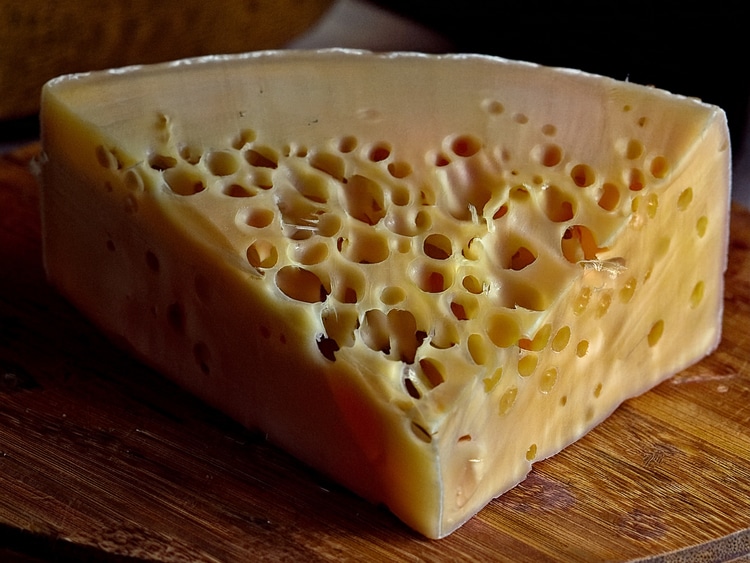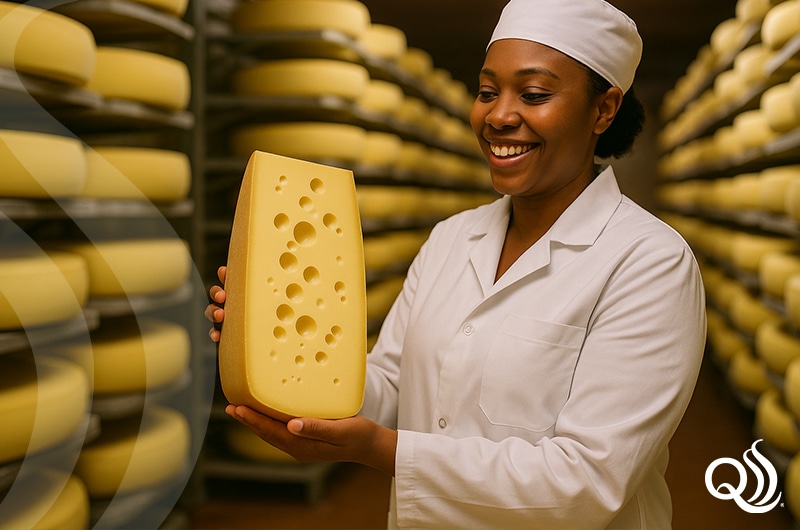Eye on the Prize: Preventing Cheese Defects by Managing Gas Formation in Swiss and Emmental Cheeses
Cheese defects resulting from abnormal gas formation, whether excessive or insufficient, can compromise product integrity, shelf life, and consumer confidence. For example, eye development in Swiss and Emmental cheeses is both a visual hallmark and a sensory signature. The size, shape, and distribution of these eyes signal not only aesthetic success but microbial precision and process control. When gas formation goes awry, defects emerge that compromise product integrity, reduce shelf life, and undercut consumer trust. While the causes of these gas defects vary, most stem from a failure to manage microbial activity at key control points. As with so many quality challenges, the problem often begins upstream.
This article explores the microbial and process causes behind gas defects in Swiss-style cheeses, differentiates between expected and unwanted gas producers, and highlights how in-process and aseptic sampling can help quality assurance (QA) teams detect warning signs before defects take form. Even cheesemakers outside Swiss and Emmental production will find useful parallels in the challenge of managing late-blowing defects, anaerobic contaminants, and culture drift.
Propionic Fermentation and Controlled Gas Formation in Cheese
In Swiss and Emmental styles, eyes are the result of propionic acid fermentation, a process driven by Propionibacterium freudenreichii subsp. shermanii. These bacteria consume lactic acid, producing propionic acid, acetic acid, and carbon dioxide (CO₂). The CO₂ forms bubbles within the cheese matrix, leading to eye development during the warm-room phase of aging, typically at 20–24°C (68- 75°F) for several weeks (Thierry et al., 2004).
For eye formation to proceed correctly, several factors must align:
- Proper acidification and buffering during early curd development
- Adequate availability of lactic acid substrate
- Tight temperature and time control in the warm room
- Balanced populations of lactic acid and propionic bacteria
Even modest deviations, such as starter imbalance, incomplete lactic acid production, or over-acidification, can alter the fermentation profile, leading to cheese quality control issues associated with gas formation in cheese. When propionic activity is too weak, eyes are small or absent (blind cheese). When CO₂ accumulates unevenly or too rapidly, mechanical openings, splits, or cracks appear.
Cheese Defects Caused by Unwanted Gas: The Role of Clostridium in Late Blowing

While Propionibacterium is an intentional contributor to Swiss cheese eye development, Clostridia, particularly Clostridium tyrobutyricum, are the microbial saboteurs of the system. These anaerobic, spore-forming bacteria enter the cheese production process via raw milk and can produce butyric acid, hydrogen, and CO₂ during cheese ripening, often weeks or months after production (Bintsis, 2006).
Clostridial contamination leads to late-blowing defects, characterized by large internal cracks, rancid or butyric off-flavors, and package swelling. These defects are especially problematic in semi-hard and hard cheeses with long ripening periods. Because Clostridia form heat-resistant spores, they are not eliminated by pasteurization and can germinate under anaerobic, nutrient-rich conditions in the cheese body (Garde et al., 2011).
Where Things Go Wrong: Process and Monitoring Gaps
Both desired and undesired gas producers pose a challenge: their impact unfolds late in the cheese production process, often long after in-plant microbial monitoring has concluded. Yet the root causes are often traceable to early-stage variables that can be measured and managed if sampling occurs at the right points.
Examples include:
- Raw milk with elevated spore loads from silage feeding or poor farm hygiene
- Culture tanks or inoculated milk with imbalanced or contaminated microbial profiles
- pH drift due to over- or under-acidification during curd development
- Residual lactose from insufficient fermentation, leading to secondary microbial activity
While endpoint product testing may reveal a gas defect, it does little to prevent the next one. That’s why in-process and aseptic sampling of raw milk, inoculated milk, curd, and whey can offer a more proactive path.
In-Process Sampling: A Tool for Prevention, Not Just Detection
Aseptic sampling ports installed at key stages, such as post-pasteurization, post-inoculation, and during early whey separation, allow processors to track microbial load, culture behavior, and spore presence in real time.
Specifically, in-process sampling can support:
- Spore count monitoring in incoming or pasteurized milk, using membrane filtration and anaerobic culturing techniques
- Starter culture validation, identifying imbalances or contaminant growth during pre-ripening
- Whey analysis during pressing or drainage to monitor acid production and lactate clearance
- pH trend tracking to ensure proper fermentation trajectories
By sampling at these points, QA teams can link microbial dynamics to process performance. For example, detecting elevated butyric spore counts in whey or milk during production allows for early intervention before product enters aging.
The Value of Correlation: Microbial Data Meets Process Behavior
Swiss-style cheesemaking is unusually sensitive to microbial balance and timing. Each phase—milk selection, inoculation, acidification, and warm-room aging—plays a role in determining gas production outcomes. That’s why microbial data must be analyzed in conjunction with process behavior rather than in isolation. When sampling data is viewed alongside fermentation curves, pH trends, and temperature profiles, a more complete diagnostic picture emerges.
For example, a rise in butyric spore counts in inoculated milk may not indicate an imminent defect on its own. But when paired with sluggish acidification or abnormally high residual lactose levels in whey, it suggests that conditions are favorable for Clostridium germination and late blowing. Similarly, if pH drop during curd formation is slower than expected, even within acceptable limits, it may signal a starter imbalance that weakens Propionibacterium activity later in the cheese production process.
Effective QA programs use these correlations to move beyond pass/fail testing. Microbial sampling, when contextualized, becomes a diagnostic tool, a way to understand not just whether a defect will occur, but why it’s likely, and how to prevent it. This is particularly important in Swiss and Emmental styles, where the interplay of organisms is complex and downstream defects stem from subtle upstream changes.
In one study, Thierry et al. (2004) noted that Propionibacterium activity is tightly dependent on lactate availability and warm room duration. In another, Garde et al. (2011) demonstrated that high butyric spore counts in whey were predictive of late-blowing defects in aged cheeses, linking sampling data directly to long-term outcomes. These findings underscore the value of a feedback loop with real-time data informing real-time decisions.
This reinforces the core truth that quality monitoring cannot end at the vat. In-process data informs not only defect detection but ongoing cheese production process refinement, especially in sensitive cheeses like Swiss, Emmental, or other gas-forming types.
Lessons for Cheesemakers Beyond Swiss Styles
Even processors who don’t make Swiss-style cheeses can take something from this discussion. Any cheese that undergoes aging, uses multiple cultures, or tolerates extended anaerobic phases is susceptible to gas defect risks. These include:
- Gouda and Maasdam (similar eye formation via Propionibacteria)
- Cheddar or Romano (vulnerable to butyric late blowing)
- Washed-rind and smear-ripened styles (open to surface colonization and gas production)
In all these cases, real-time microbial visibility through strategic sampling can mean the difference between consistent quality and late-stage loss.
Gas defects in Swiss and Emmental cheeses are more than cosmetic; they are the visible signs of microbial imbalance and process drift. Whether caused by weak Propionibacterium performance or the disruptive force of Clostridium spores, these defects tell a story that begins upstream. By integrating aseptic in-process sampling into raw milk, inoculation, and early curd workflows, cheesemakers can catch early microbial signals, validate fermentation behavior, and intervene before CO₂ becomes a problem. Even for those outside the world of eye formation, the principle holds: sampling reveals what is forming beneath the surface.
Stop cheese defects before they start.
Get the right sampling solution for your process:
- Request for Quote: Select products, submit, and get pricing fast.
- Custom Quote Form: Tell us your challenge—our experts will recommend the best system.
You can also call us at (651) 501-2337 or email [email protected] to learn more!
Frequently Asked Questions About Cheese Defects
Q: What are the most common cheese defects?
Cheese defects are flaws in appearance, texture, taste, or smell that happen during production or storage. In Swiss and Emmental-style cheeses, common issues include gas formation, uneven holes, off-flavors, and texture changes.
Q: What causes gas defects in cheese?
Gas defects in cheese happen when unwanted bacteria or other microbes create excess gas during ripening. Causes include contamination from milk, poor sanitation, improper starter culture balance, or incorrect pH and temperature control.
Q: How do you prevent cheese defects in Swiss cheese?
To prevent defects, cheesemakers need clean, high-quality milk, strict hygiene, good starter culture management, and close control over temperature and pH. Using aseptic sampling systems at key points helps detect contamination before it causes problems.
Q: How does aseptic sampling help with cheese defects?
Aseptic sampling allows you to collect milk or whey samples without introducing contamination. This means you can check for harmful bacteria early, confirm sanitation is working, and make corrections before defects appear.
Q: Can you always see gas defects in cheese?
No. Early gas formation may not be visible at first. That’s why regular microbial testing and monitoring are critical to catch problems before they affect cheese quality.
Q: Can cheese with defects still be sold?
It depends on the severity. Minor defects may still be acceptable for certain products, but major defects—like strong off-flavors or excessive holes—can lead to rejected batches and lost sales.
References:
Bintsis, T. (2006). Microbial pollution and food hygiene. Dairy Science & Technology, 86(4), 261–266.
Garde, S., Arias, R., Suárez, J. E., & Rodríguez, A. (2011). Development of a new selective medium for the detection of Clostridium tyrobutyricum in cheese. Journal of Dairy Science, 94(4), 1801–1808.
Thierry, A., Maillard, M. B., & Richoux, R. (2004). Propionibacteria in Emmental cheese: Detection by in situ hybridization and influence on aroma. Lait, 84(1–2), 93–109. https://doi.org/10.1051/lait:2004003
Thierry, A., Deutsch, S. M., Falentin, H., Dalmasso, M., Cousin, F. J., & Jan, G. (2011). New insights into physiology and metabolism of Propionibacteria in cheese. International Journal of Food Microbiology, 149(1), 19–27. https://doi.org/10.1016/j.ijfoodmicro.2011.03.007




